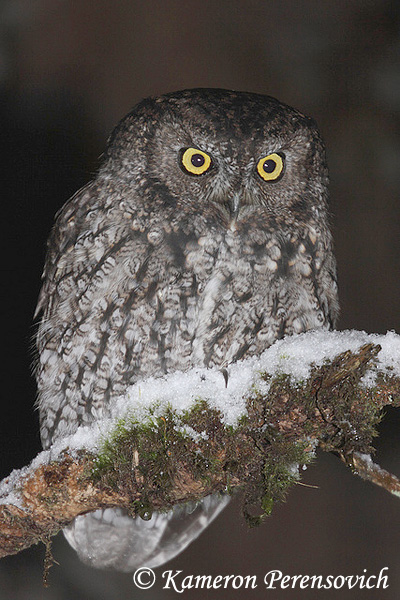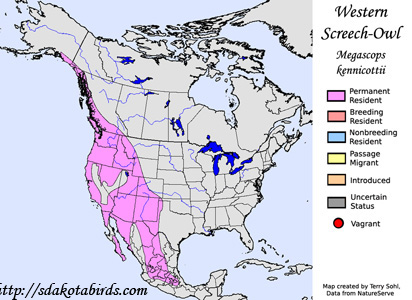| Length: 8.5 inches | Wingspan: 20 inches | Seasonality: Non-resident in South Dakota |
| ID Keys: Grayish overall, dark streaks on underparts, dark-colored bill, yellow eyes, short ear tufts. Also a brownish morph. | ||
 The
Western Screech-Owl is a very common owl of western North America.
They can be found from forest lands in Alaska southward through deserts of
the American Southwest, and into Mexico. They are very similar in
appearance to the Eastern Screech-Owl,
and until 1983, both were considered one species. Either the Eastern
Screech Owl or Western Screech-Owl can be found in much of the Americas, but
the two have different voices. In the very small area where the two
species' ranges overlap, voice is practically the only feature that can used
to distinguish between them. As with the Eastern Screech Owl, Western
Screech Owls have adapted quite well to a human presence, and can often be
found in urban parks and forests as well as in more natural woodlands,
although their nocturnal nature makes them an often unseen presence.
The
Western Screech-Owl is a very common owl of western North America.
They can be found from forest lands in Alaska southward through deserts of
the American Southwest, and into Mexico. They are very similar in
appearance to the Eastern Screech-Owl,
and until 1983, both were considered one species. Either the Eastern
Screech Owl or Western Screech-Owl can be found in much of the Americas, but
the two have different voices. In the very small area where the two
species' ranges overlap, voice is practically the only feature that can used
to distinguish between them. As with the Eastern Screech Owl, Western
Screech Owls have adapted quite well to a human presence, and can often be
found in urban parks and forests as well as in more natural woodlands,
although their nocturnal nature makes them an often unseen presence.
Habitat: Western Screech-Owls can be found in a variety of vegetated habitats. Throughout much of their range, they are primarily found in open forest and along forest edges and clearings. In desert areas, they can be found in areas of Saguaro and other large cactus. They typically are not found in higher-elevation forests.
Diet: The diet of a Western Screech-Owl consists of a variety of small creatures. Large insects and spiders make up a large portions in many locations when available, but they will also feed on small rodents, small birds, small snakes, lizards, frogs, amphibians, and occasionally, fish and crayfish.
Behavior: Nocturnal, feeding at dusk and through the night. Most hunting is done by observing from a perch and swooping out to catch prey in its talons when spotted. They are also capable of catching insects in flight.
Nesting: The nest of a Western Screech-Owl is most often a cavity in a tree. In range they will also use cavities in large cactus. They have also adapted to use cavities in man-made objects such as telephone poles and specially constructed nest boxes.
Song: Song of a Western Screech Owl is a series of whistling notes that accelerate in pace, with lower notes towards the end. They also have other barking, cackling, or hooting sounds.
Migration: Considered a permanent resident throughout its range.
Interactive eBird map: Click here to access an interactive ebird map of western Screech-owl sightings
Similar Species: Whiskered Screech-Owl, Eastern Screech-Owl
Conservation Status: There are currently no perceived major threats to Western Screech-Owl populations, and the IUCN cites it as a species of "Least Concern".
Further Information: 1) Cornell's All About Birds - Western Screech-Owl
2) OwlPages.com - Western Screech-Owl
3) BirdWeb.com - Western Screech-Owl
Photo Information: December 30th, 2011 - Sitka, Alaska - Kameron Perensovich - Photo licensed through Creative Commons Attribution/Share-Alike 2.0 Generic License.
| Click below for a higher-resolution map |
 |
| South Dakota Status: Non-resident in South Dakota |
Additional Western Screech-Owl Photos (coming soon!!)
